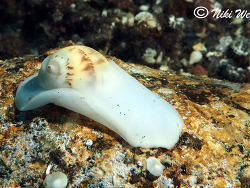Info
Payraudeautia intricata (Donovan, 1804)
Payraudeautia intricata belongs to the family Naticidae, the umbilical snails. Members of the family have spherical shells with a crescent-shaped opening, which is why they are also known as moon snails.
Moon snails have a horny or calcareous operculum. They can be found worldwide, even in the Arctic and Antarctic.
Payraudeautia intricata lives in the Mediterranean to the North Atlantic. This small moon snail drills holes in the shells of other molluscs with its rasping tongue in order to eat their contents. It is a predatory species.
The sand collar is the egg mass of a moon snail. A moon snail lays its eggs at night. The eggs are laid individually in capsules that are embedded in a matrix of sand grains - a combination of mucus and sand that forms a gelatinous layer and hardens. This forms an upright, roundish sand collar.
Synonymised names:
Euspira intricata (Donovan, 1804) · unaccepted
Natica (Payraudeautia) intricata (Donovan, 1804) · unaccepted
Natica crassatella Locard, 1886 · unaccepted
Natica grisea Requien, 1848 · unaccepted
Natica intricata (Donovan, 1804) · unaccepted
Natica valenciennesii Payraudeau, 1826 · unaccepted
Nerita intricata Donovan, 1804 · unaccepted (original combination)
Payraudeautia alleryana Sulliotti, 1889 · unaccepted
Payraudeautia peloritana Sulliotti, 1889 · unaccepted
Payraudeautia similis Monterosato, 1884 · unaccepted
Payraudeautia similis var. major Monterosato, 1884 · unaccepted (synonym)
Payraudeautia intricata belongs to the family Naticidae, the umbilical snails. Members of the family have spherical shells with a crescent-shaped opening, which is why they are also known as moon snails.
Moon snails have a horny or calcareous operculum. They can be found worldwide, even in the Arctic and Antarctic.
Payraudeautia intricata lives in the Mediterranean to the North Atlantic. This small moon snail drills holes in the shells of other molluscs with its rasping tongue in order to eat their contents. It is a predatory species.
The sand collar is the egg mass of a moon snail. A moon snail lays its eggs at night. The eggs are laid individually in capsules that are embedded in a matrix of sand grains - a combination of mucus and sand that forms a gelatinous layer and hardens. This forms an upright, roundish sand collar.
Synonymised names:
Euspira intricata (Donovan, 1804) · unaccepted
Natica (Payraudeautia) intricata (Donovan, 1804) · unaccepted
Natica crassatella Locard, 1886 · unaccepted
Natica grisea Requien, 1848 · unaccepted
Natica intricata (Donovan, 1804) · unaccepted
Natica valenciennesii Payraudeau, 1826 · unaccepted
Nerita intricata Donovan, 1804 · unaccepted (original combination)
Payraudeautia alleryana Sulliotti, 1889 · unaccepted
Payraudeautia peloritana Sulliotti, 1889 · unaccepted
Payraudeautia similis Monterosato, 1884 · unaccepted
Payraudeautia similis var. major Monterosato, 1884 · unaccepted (synonym)







 NikiWei
NikiWei



